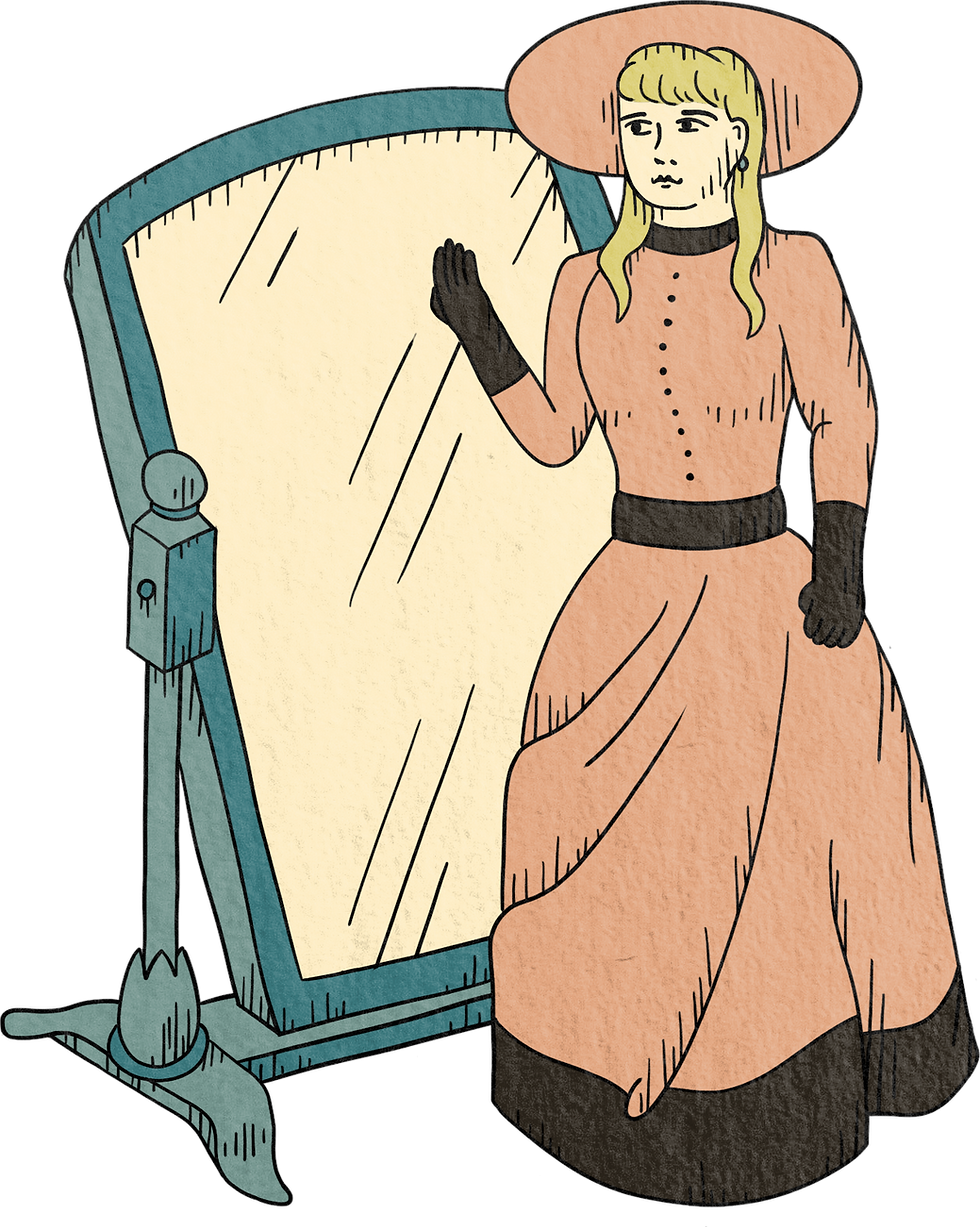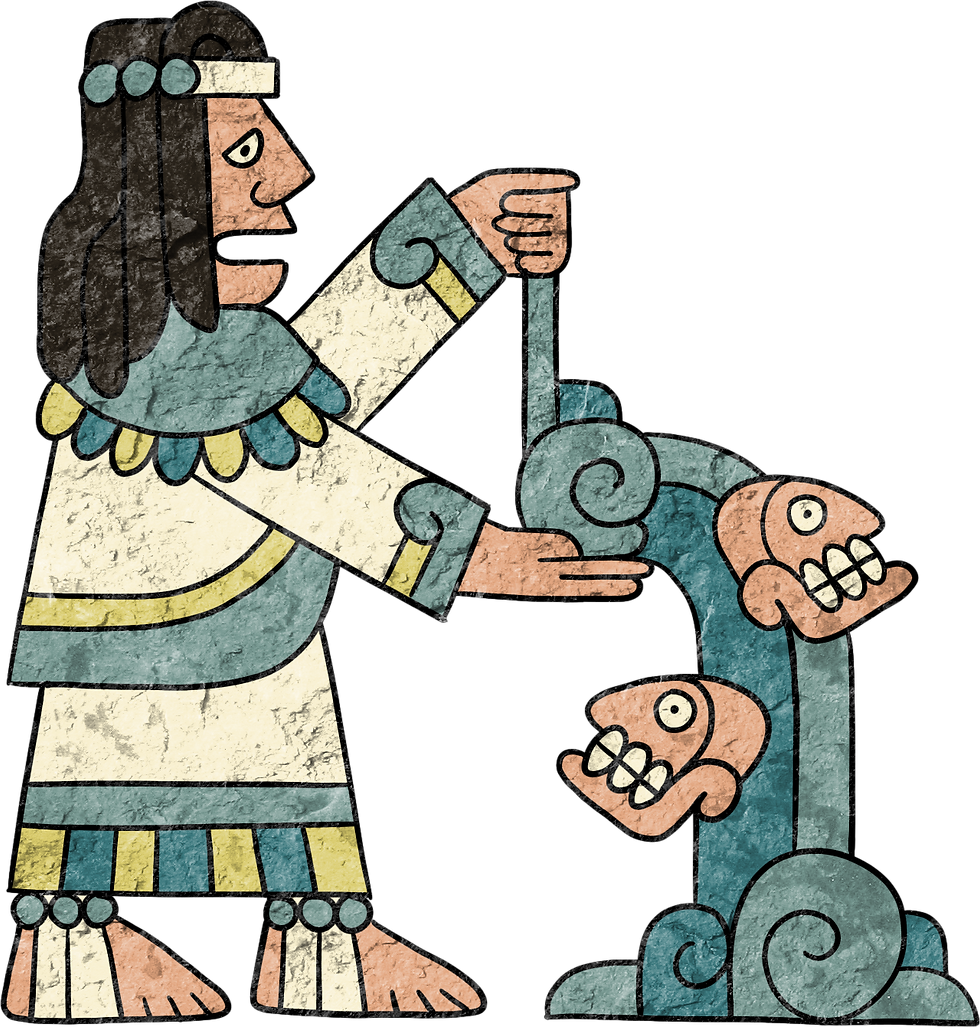Getting To Know Your Ghosts: A Look Into History’s Most Fearsome Female Familiars
- slbailey22
- Mar 28, 2022
- 5 min read
By Sadie Weil
Art by Amon Ferri
Ghosts take on many amorphous forms. Some people believe not only that humans are composed of simultaneous physical and spiritual entities, but also that the spirited dimension is eternal. In some traditions, ghosts appear in their corporeal form, only revealing their otherworldly nature through their off-putting behavior before vanishing without a trace. Their previous human selves have died in agony or due to a traumatic event and are unable to rest in peace, while others are kept as sentient ghosts to be tortured for their evil human ways. Some are ancestors guiding us from above, while others are manifestations of inanimate lifeforms.
In popular folk culture, female ghosts often straddle the Madonna-Whore complex.[1] Believed to have suffered trauma in life or a tragic death, the series of ghosts categorized as "White Ladies" bisects the global boundaries of gender, race, and socioeconomic roles.[2]

Okiku from Japan exemplifies many white ghost characteristics. Once a beautiful servant, Okiku sealed her fate when she refused the love of her samurai master. Overtaken with anger, he tricked her into believing she had lost one of his family’s precious plates. As such a crime normally would have resulted in a death sentence, the samurai offered to forgive her if she accepted his offer of love. Once again, she refused and was thrown down a well. Okiku became a vengeful spirit who tormented her murderer by counting to nine and then making a terrible shriek to represent the missing tenth plate. Perhaps she is tormenting herself by trying to find the tenth plate and cries out in agony when she never can.[3] Okiku’s tale represents some of the conditions women faced under samurai-rule in feudal Japan. During the Kamakura shogunate, the first era of Japan’s bakufu period, the proliferation of more democratic Buddhism in Japanese society afforded women privileges previously unheard of.[4] As the feudal area progressed and Japan became more nationalistic, women’s rights began to revert to tradition. Female-male roles began to reflect that of the lord and subject feudal ideal. Okiku’s status as a woman of the lower class puts her in a prime position to experience the terrors of male-military rule. Her gender and her lack of socioeconomic privilege make her a good victim for the terrors of male violence as she is afforded little access to social mobility. The true terror of Okiku’s ghost story lies not in her camp-y revenge upon her murderer, but in the probabability that women of this pedigree were historically likely to face similar ministrations and violent coersive tactics from men in positions of power.
La Llorona is perhaps the most famous White Lady archetype. In a typical version of the legend, a beautiful woman named María marries a rich conquistador to whom she bears two children. One day, María sees her husband with another woman and in a fit of blind rage, drowns their children in a river. Consumed by guilt, she drowns herself as well but is unable to enter the afterlife, forced to roam this earth until she finds her children. In another version of the story, her children are illegitimate, and she drowns them so that their father cannot take them away to be raised by his new wife. Recurring themes in variations on the La Llorona myth include a white wet dress, nocturnal wailing, and an association with water.[5] La Llorona is typically rumored to snatch up lost children, mistaking them as her own. The deployment of this ghost story as a cautionary tale teaches children sexual taboos, as it teaches children to repress their individuality by staying in the fold of family, community, and religious dogma. La Llorona promotes the image of a woman dependent on a man for pleasure, as fickle and prone to disproportional responses when faced with unexpected life events, and as driven by passion.[6] The indoctrination of La Llorona into the canon of female ghost stories, represents the ability of ghost stories to capture common conceptions of gender present in a society at a certain time. Once again, the part of the real horror lies not in the tale, but in the depiction of the society it portrayed.

Many of the ghost tales concerning Red Lady ghosts in America arise from attachments to historic sites, often concerning the sex trade in old mining communities.[7] Cited as typically friendly in disposition, the Red Lady ghost is more specifically attributed to a jilted lover, or a sex worker killed in a fit of passion. She is then tied to the location of her murder, usually a bordello, saloon, or hotel, rumored to appear beautifully.[8] Prior to the late nineteenth century, sex work was considered a moral failure, but not a crime. The criminalization of sex work arose as cities began to grow in the American West, but efforts to eliminate the sale of sex ultimately failed. The direct growth of prostitution in urban areas correlates with the shifting of the family that arose during this period of time.[9] As families sought gold or other fortune in the Wild West, all members of the nuclear family were forced to work for wages. If a woman found herself orphaned, divorced, widowed, or simply alone, finding employment could be impossible. Urban sex work drew its employees from various racial groups. White women, Black women, Asian women — often trafficked from China as young girls — as well as Native American women and Mexican women worked.
Oftentimes, success trickled down to matters of race. Women of color were objectified with “exotic” names, such as China Mary, and faced higher rates of discrimination and a lower likelihood of ascending the rungs of economic and social hierarchies. The most common form of death among sex workers was suicide, but many also perished via drug overdoses and alcohol poisoning. Murder was also prevalent as well as natural illness developed from egregious living conditions. The Red Lady ghost typology envisions these women at their prime as sexual figures enrobed in red, before being brutally killed by a male suitor. The Red Lady exemplifies the dreams of the West as a place of sin, freedom, and economic prosperity; however, it is an unviable reality for those with disadvantages.
Origins of ghost and apparition horror lie in the structural inequalities that govern who succeeds in life. The female ghost archetype often takes this a step further by envisioning the victim as an object of sexual desire coupled with a sense of unattainability due to her eerie beauty. Meant to represent the dreams of men to conquer a new frontier coupled with a phallic fascination with the sexual objects, female ghosts arose, ultimately embodying the failures of these societies.

__________________________________________________________________________________
[1] Alexandra Salyer, “Of Madonnas and Whores.” Spare Rib 21X Edition. https://www.spareribdartmouth.com/post/of-madonnas-and-whores.
[2] Wikipedia contributors, "White Lady," Wikipedia, The Free Encyclopedia, https://en.wikipedia.org/w/index.php?title=White_Lady&oldid=1074332859.
[3] Wikipedia contributors, "White Lady," Wikipedia, The Free Encyclopedia
[4] “Legends and Chronicles,” Feudal Japanese Women, accessed March 1, 2022, https://www.legendsandchronicles.com/ancient-civilizations/feudal-japan/women-in-feudal-japan/.
[5] Wikipedia contributors, "La Llorona," Wikipedia, The Free Encyclopedia, https://en.wikipedia.org/w/index.php?title=La_Llorona&oldid=1074033373
[6] La Chucana, “La Malinche and La Llorona as Chicana Archetypes: History, Symbolism, and Influence on Chicana/o Culture and Literature,” La Malinche and la Llorona as Chicana Archetypes: History, Symbolism, and Influence on Chicana/o Culture and Literature https://chucana.blogspot.com/2010/12/la-malinche-and-la-llorona-as-chicana.html.
[7] Wikipedia contributors, "Lady in Red (ghost)," Wikipedia, The Free Encyclopedia, https://en.wikipedia.org/w/index.php?title=Lady_in_Red_(ghost)&oldid=1070500023
[8] Wikipedia contributors, "Lady in Red (ghost)," Wikipedia, The Free Encyclopedia
[9] Sandra Mather, “Ladies of the Night: History of Prostitution in the Mining Days,” SummitDaily.com (SummitDaily.com, December 22, 2020), https://www.summitdaily.com/news/ladies-of-the-night-history-of-prostitution-in-the-mining-days/.



Comments